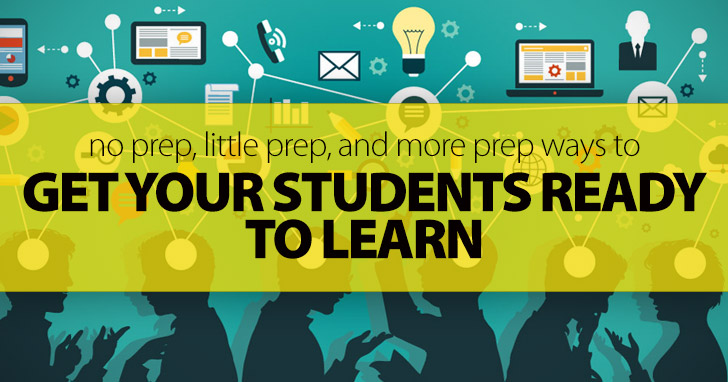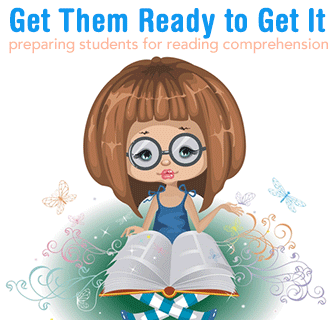No Prep, Little Prep, and More Prep Ways to Get Your Students Ready to Learn


- Did you understand what you read?
- Yes.
- What did the article say?
- I don’t know.
It can be frustrating for teachers and students alike. We may not be able to change how students will answer our questions, but we can help them increase their reading comprehension with a simple prereading activity. Here are some simple strategies you can use with your English students to get them ready to understand what they read.

Helping ESL students increase their reading comprehension starts by making connections to what they already know. In technical terms, this is called activating the schemata. In practical terms, it just means bringing what they already know to the forefront of their minds so they can anchor the new material to what they currently know. For example, if you tried to memorize a list of groceries you need to pick up, you might not have much success. However, if you know that you need bread to feed the ducks when you go to the park, water to take on your walk there and a cake to have for the party later that afternoon, you might have a better chance of remembering what you need. You are connecting your grocery list to the schedule you already have established in your mind. Your ESL students will have better understanding of the text that they read when they can make similar connections to what they already know or have experienced. How do you do that? Get them thinking about the topic at hand before you have them read.
You do not have to use a tricky or subversive means to figure out what your students already know about a particular topic, just ask them. The most straightforward way for your students to organize what they already know is in a K/W/L chart. If you have never used one before, it is a simple, three column list labeled Know, Want to Know, and Learned. As a class, in small groups or individually, ask students to fill in the first column of the chart. For example, if your students were preparing to read an article on American football, ask them what they already know about the sport. On the board, you would list the facts as they give them to you. “It’s played in the U.S. It uses an oval ball. Men run into each other. It is a professional sport.” Some students’ responses might jog other students’ memories. You would continue with the exercise until no one had anything new to add to the list.
Then, you move on to the second column, what you want to know. Ask students what questions they would like to have answered about the topic. If it were football, they might want to know why the ball is shaped the way it is, what the different positions are on the team, or how a team scores. Continue brainstorming this list until there are no more questions from the class. Through this activity, your students will see that they have more to learn about the topic at hand, and it may raise their curiosity and motivate them to engage more with what they read.
At this point, you would introduce the reading material to your students. After they have completed the reading, they would move to the last column of the chart. Here they would list the facts that they learned from the reading. Some facts may answer questions in the class noted in column two, but they do not have to. The point is that your students will remember the new facts that they learned because they have linked them to what they already know about the subject. Not only that, they will have confidence that they can understand a complex topic and make headway as they learn even if they are reading in a second language.
Sorting is another great way of getting students engaged in material that they will read about. The most simple sorting activity uses important vocabulary from the reading. Rather than just going through a list of new words to prepare your students, write each important word from the text on an index card. Your words should include both new vocabulary as well as words with which your students are already familiar. You will need one set of the same cards for each group of 3 to 4 students. Once students have the cards, ask them to sort the cards in a way that seems logical to them. Encourage them that there is no wrong way to sort their cards, but they will need to explain their reasoning behind the sort. Once each group has finished sorting their cards, give them an example of how you sorted the same group of words.
For example, if you were going to read about football, you might give your students words such as field goal, quarter back, lineman, coach, score, field, players, run, throw and defense. Then you could show your class your sorting technique which groups people (player, coach, quarterback, lineman) and actions performed in the game (throw, run, score). It is okay if students are unable to fit some words into their sort (field goal, field, defense in this example). Simply explain that you will need to fit these words into your sort after reading the material.
If your students will be reading a fictional piece, you may want to have them sort with a different strategy. Still give your students the important pieces of vocabulary in the reading, but then ask them to sort those words into these categories: character, setting, conflict and resolution. Once students have sorted the words, ask them to predict what might happen in the story. If you like, you may want them to write out their predictions or have them share the predictions with a partner.
When you start by getting kids thinking rather than just jumping into the material, your students will be more successful readers and retain more information than they would otherwise.
What other graphic organizers do you like to use in reading class?